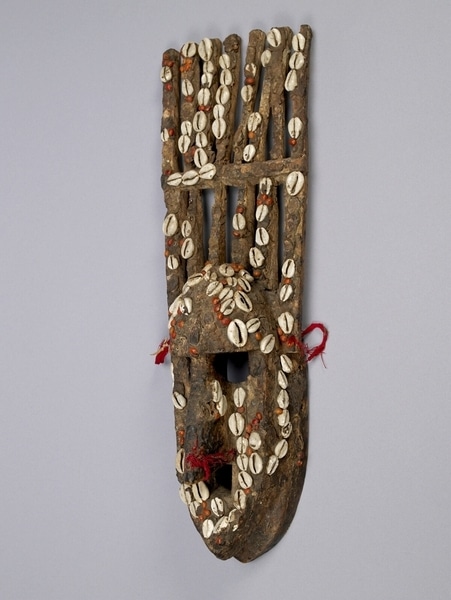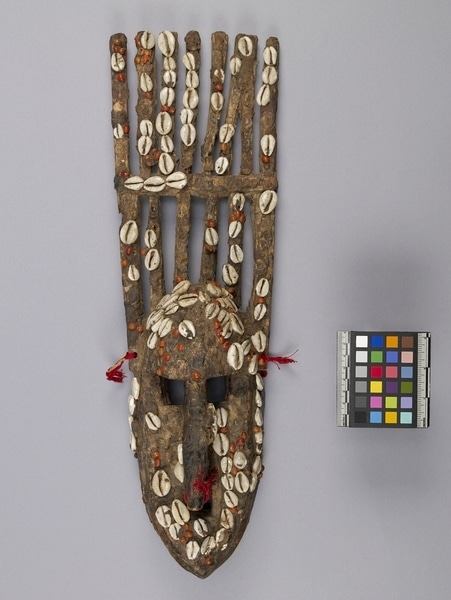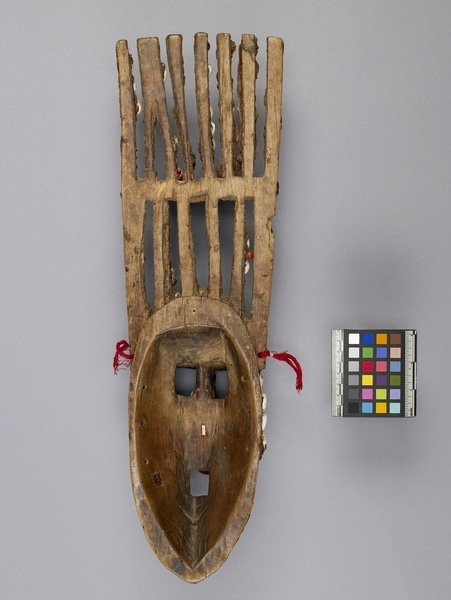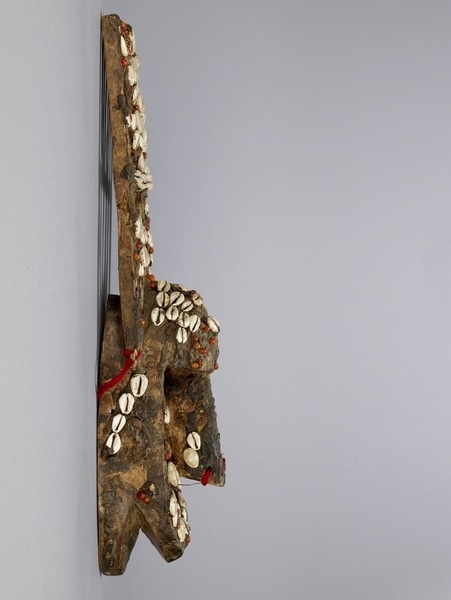Mask Item Number: 1001/1 from the MOA: University of British Columbia




Description
A long oval-faced wood mask with a tall six-stick headdress connected horizontally in the middle. The nose is long, thin, and deep with strands of red thread wrapped around its nostrils. The square eyes and mouth are cut out. The forehead is upraised and angled to a point in the middle. Double chin. Entire mask is decorated with cowrie shells and red seeds.
History Of Use
Male N'tomo, or N'domo, mask from the N'tomo society, a Bamana initiation society dedicated to boys six to twelve. Prior to being initiated the boys would be expected to learn koré, which is N'tomo knowledge, history and discipline, and then during the rite of passage demonstrate the knowledge. The rite of passage, to enter the ton- the male population between twelve to thirty-five, was a circumcision ceremony. The ceremony would be led by the Chief N'domo, who wore the N’domadyiri mask, which was said to represent their god; initiates would wear their N'tomo masks during the ritual. The time between these ceremonies could be as long as seven years. The N'tomo masks would either have small mouths or none, showing that silence, keeping secrets, and controlling one's speech are important values. The mask wearer would wear a cloth around their waist, and walk through his village and enter their family compound, announcing the start of a puppet masquerade and the yearly festival, checko.
Specific Techniques
N’tomo masks are carved using m’peku wood, which grows around Bamana villages. To harvest the wood, cowrie shells are often given to trees as offerings to the spirit Nyama, which exists in all living natural things; the spirit will also live in the wood of the mask. Afterwards, the mask is coated in oil to protect it.
Iconographic Meaning
Each mask represents a Bamana ancestral spirit and the wearer is to represent that spirit respectfully and accurately; failure to do so can lead to punishment. The length of prongs on the mask represents the wisdom of the spirit and wearer; the longer the prong, the wiser they are. The size of the forehead indicates the size of intelligence of the spirit and wearer. The number of horns along the top of the mask indicates the gender of the dancer's role. While only boys take part in these performances, they can perform any gender. Males are represented by three or six horns while females are represented by four or eight horns. Androgyny is represented by two, five, or seven horns. The prongs themselves represent the eight primordial seeds used by their god to create the universe.
Item History
- Made in Mali
- Owned by Tradewind Antiques before October 17, 1984
- Received from Museum of Anthropology Shop Volunteers (Funding source) and Tradewind Antiques (Seller) on October 17, 1984
What
- Name
- Mask
- Identification Number
- 1001/1
- Type of Item
- mask
- Material
- wood, cowrie shell, seed and fibre
- Overall
- height 50.0 cm, width 15.5 cm, depth 12.0 cm
Who
- Culture
- Bamana
- Previous Owner
- Tradewind Antiques
- Received from
- Museum of Anthropology Shop Volunteers (Funding source) and Tradewind Antiques (Seller)
Where
- Holding Institution
- MOA: University of British Columbia
- Made in
- Mali
When
- Ownership Date
- before October 17, 1984
- Acquisition Date
- on October 17, 1984
Other
- Condition
- fair
- Accession Number
- 1001/0001